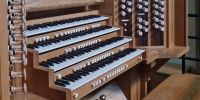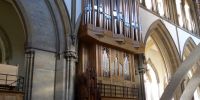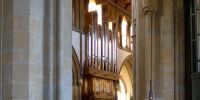
Llandaff Cathedral stands on one of the oldest Christian sites in Britain, with the present building dating back to 1107.
Following the removal to St Mary’s, Usk of the cathedral’s fine 1861 Gray & Davison, an organ was built in 1900 by Hope-Jones / Norman & Beard, was modified by Norman & Beard in 1914 and 1924, and in 1937 received a complete reconstruction by Hill, Norman & Beard. Unfortunately, in January 1941 a German landmine devastated the building and its organ but as the cost to rebuild the cathedral was so great, the organ could only receive a ‘make do and mend’ restoration.
For over thirty years, discussions had taken place about the cathedral organ. It was poorly located, with a cramped internal layout and surrounded by screens which prevented the sound from being effective in the building. For decades, its general condition had been in decline and very expensive to repair. It was finally rendered unusable for daily services by a lightning strike in February 2007 and a digital organ was hired to continue the choral tradition at Llandaff.
Nicholson & Co was awarded the £1.5m contract to replace the organ with a completely new instrument. This British-built organ is the largest to be commissioned in a UK cathedral since 1962 and successfully combines traditional workmanship together with the latest technological innovations.
The organ was built in two symmetrical cases, situated either side of the Choir, and contains a total of 4870 pipes now that the Solo organ has been installed. The stop list marks a return to the romantic English style. Great, Solo and Pedal divisions are located in the two bays in the North Choir with the Swell, Choir and console opposite in the South Choir. The organ cases, designed by Simon Platt, frame Sir Jacob Epstein’s statue of Christ in Majesty, a unique architectural feature which is recognised around the world.
Construction began in September 2008, moving to the cathedral in April 2009. The partially completed organ was opened on schedule for Easter 2010. Further fund raising enabled the final stage of work to commence, and the organ was taken out of service during the summer of 2013 to complete the Solo and Pedal organs. The opening recital of the fully completed organ was by Robert Quinney on 8th November 2013.

















